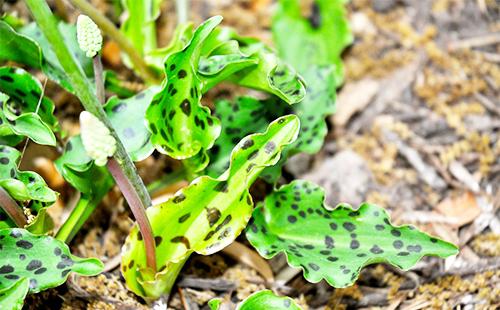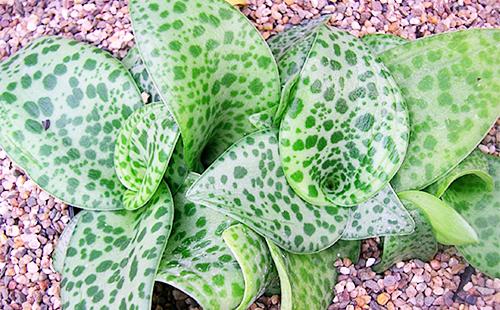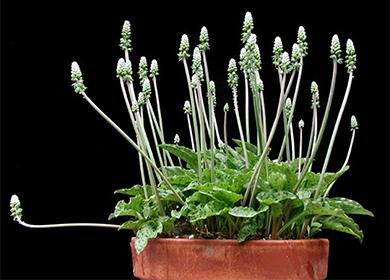The content of the article
Dreamiopsis is an exotic culture, not too picky. Several varieties are common, each of which has its own characteristics.
Description and types
Many people confuse dreamiopsis with eucharis, but these are completely different cultures. You can distinguish them during the flowering period: the second plant blooms more pronounced.
The root system of dreamiopsis is represented by a chocolate-brown hue. The foliage is compacted, with a glossy monophonic coating, in some varieties it may be with a pattern. The shape of the leaf resembles an oblong oval or heart with a pointed end. Dark dots and spots are visible on the surface of the olive-green color. The length of the leaves is about 15-20 cm, petioles - 10 cm.
Leaves of culture are the core value. If proper care is provided, a pattern appears on them. There are about 22 species of this plant, among which the following two are most popular.
- Spotted. It is also often called petiolebury. Culture is growing in South Africa. The leaves are long, oval-heart-shaped, painted in a saturated green color. Dark green spots are also visible on the surface. Flowers are located on long stalks. Flowering begins in April and ends in July. Grayish or yellow buds with a delicate aroma. With the onset of autumn, the plant crumbles and prepares for rest.
- Pickaxe. The second name is ledeburia botryoid. The main place of growth is East Africa. The culture bulb is white, the leaves are lanceolate in a light green hue. There are dark green spots on the surface. Small white buds are located on a long peduncle. Flowering begins in March and ends in September. The maximum height of the stems is 40 cm.
Only these two species are cultivated. Small flowers are collected in an ear or brush. In one inflorescence, there are up to 30 buds with a diameter of 5 mm.
Basic care
In order for the plant to be healthy and beautiful, it must be properly looked after. Consider the following recommendations.
- Lighting. Light is the main condition that ensures the saturation of the leaves. Lighting should be bright. The culture tolerates the direct exposure to the sun, but in the heat it is better to put it a little in the shade. After acquiring a flower or at the end of a dormant period, it must be accustomed to the sun gradually. It is better to locate the culture on the windowsills that face the south side.
- Temperature. The flower feels good at temperatures of 20-25 ° C. With the onset of autumn and winter, the mark of the thermometer should be reduced to 14 ° C.
- Watering. At the moment of active growth and opening of buds, the plant is watered as necessary. The soil should always be slightly moistened. But if you fill the flower, this will lead to decay of the root system. At rest, watering is minimized, but does not stop.If the leaves fade, you need to strengthen it, as well as increase the humidity.
- Air humidity. Indoor scylla species carry both dry and moist air. The leaves do not need to be sprayed, just wipe with a damp cloth from dust.

Transplantation and reproduction
Soil for the culture you need to choose loose. You can use a substrate for bulbs, which retains moisture well. If the soil is loose, peat or sand can be added to it. Also use turf land.
The capacity in which the bulb is transplanted must be with drainage. Dreamiopsis forms children, but the bulb does not grow. The pot should not be tall, but wide, in the form of a bowl. It is better to choose ceramic products. They will provide good air exchange and help prevent bulb decay. A deep pot for culture is not suitable, as it can lead to rotting of the root system and slow down the growth of shoots.
Young plants are transplanted every year. With each new transplant, the pot increases in diameter by 2-3 cm. If the culture is about three to five years old, it is enough to transplant it once every two years. Then the transplant will be carried out in three to four years, when the bulb will have many children.
The optimal period for transplantation is considered the beginning of spring or its middle. In the process of transplantation, the bulb should be well examined and removed all affected areas. Put claydite in combination with charcoal and river sand at a thickness of at least 3 cm at the bottom of the tank. On top is a prepared substrate to a height of about 3/4 of the volume of the tank. Moderately water the ground. Extract culture from a small pot, shake off the ground a little and separate the children. To clean the decaying and dry parts of the root system, then treat the damaged areas with carbon powder. Make a deepening in the soil and place the onion in it. Compact and moisten the soil on top.
Reproduction is carried out both by shifts and by dividing the bulbs. Children are separated during a culture transplant, and damaged areas are treated with chalk or ash. You can also propagate the culture using leaves. They need to be separated at the base of the bulb with the petiole and rooted in water or peat soil.
Propagation by seeds takes time and patience. It is carried out quite rarely, since it is difficult to obtain fruits.
Pests
Most often, the following parasites attack the culture.
- Shield. The soil becomes an unnatural black hue, and yellow-red patches with convex outgrowths of a grayish hue are formed on the surface of the leaves. They grow very quickly and affect the plant. It is necessary to treat the surface with a thick foam of laundry soap and rinse with warm water after an hour. Next, the flower is sprayed with "Fufanon" or "Metaphos". The tool is applied to the soil. To maximize the effect, you need to cover the culture with cellophane for two days.
- Spider mite. This pest leaves a thin web on the surface of leaves and petioles. Black dots and yellowish spots also appear. In this case, you need to perform the processing with a solution of alcohol and soap, rinse after 30 minutes with water, pour over the soil and cover the flower with a bag for three days. Use acaricides throughout the week.
- Aphid. Forms plaque, small beige dots and damages leaves. If the problem has just appeared, it is enough to spray with infusions of plants with a sharp aroma. When there are a lot of aphids, special preparations of Inta-Vir or Aktara are necessary.
- Mealybug. It forms dirty white lumps located between the scales of the bulb. A layer of white substance resembling wax is also visible on the surface of the soil. The foliage must be treated with alcohol or alcohol tincture, rinse after 20 minutes. Next, irrigate with a solution of Tanreka or Aktara for a week.

Disease
Usually the flower is sick due to improper care.
- Root rot. It appears in the form of blackened petioles, which are slippery to the touch. The unpleasant smell of rot also manifests itself. Affected foliage easily separates from the base. In such cases, you need to cut off all the damaged areas and transplant the flower into a new container and soil. You also need to add "Glyokladin" or "Trichodermin" to the soil.
- Stagonosporosis. Also, the disease is called a "red burn." Small spots with a reddish tint and cracks appear on the surface of the bulb and leaves. It is necessary to reduce watering and keep the soil a little dry for a month. Remove the affected areas from the bulb. Treat injured areas with iodine or brilliant green, sprinkle with charcoal.
For the culture to be healthy and strong, it needs to be fertilized. Suitable drugs with potassium, calcium and nitrogen. The same means are used as for cacti, bulb, succulents. It is enough to feed a flower once or twice a month in the spring and summer. This is important for maintaining growth.

